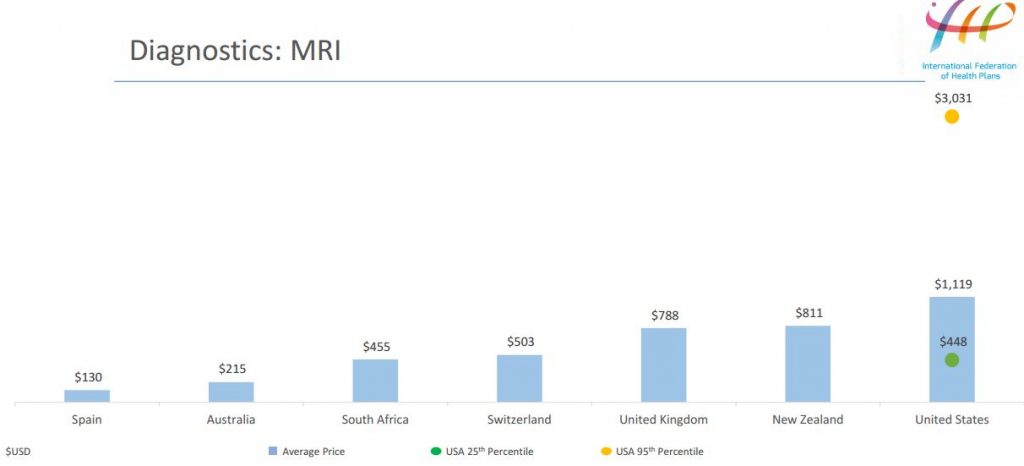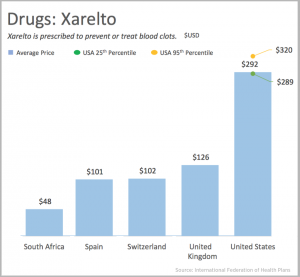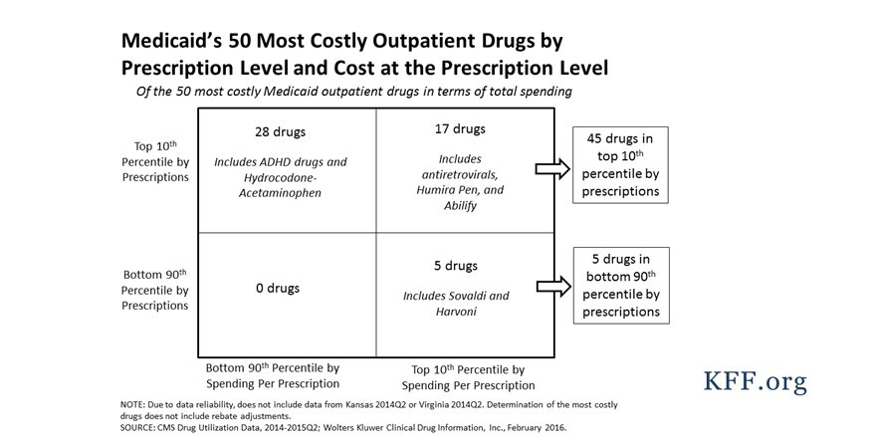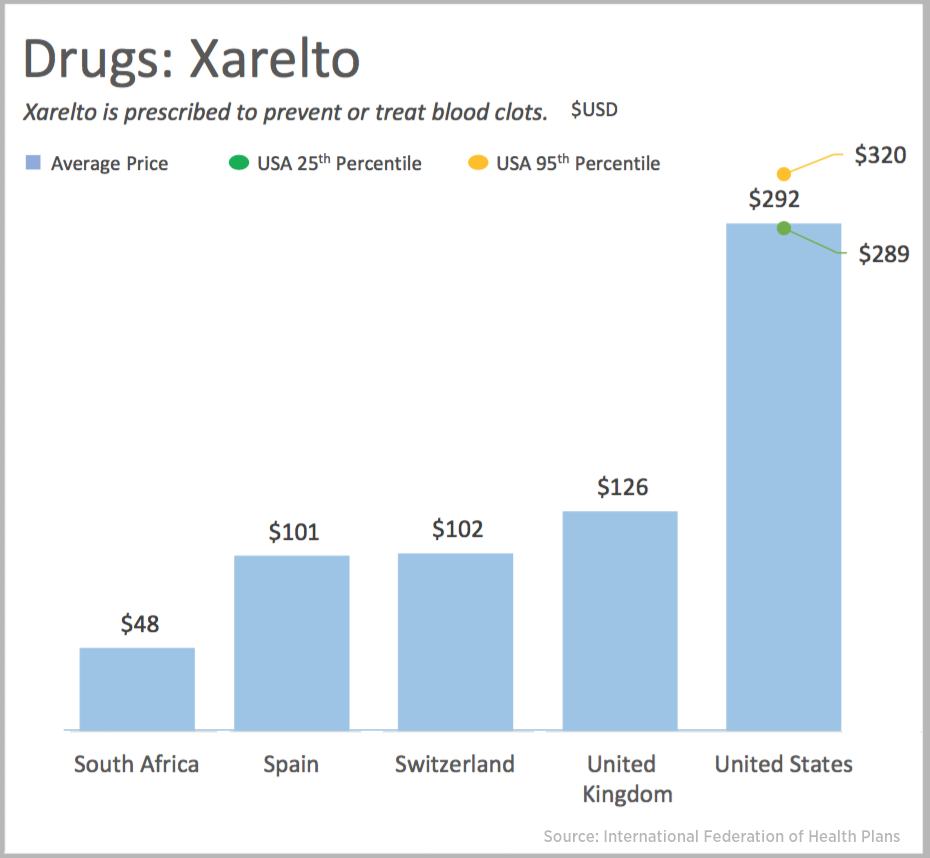 The average hospital cost per day in the U.S. is $5,220. In Switzerland it’s $4,781, and in Spain that inpatient day looks like a bargain at $424.
The average hospital cost per day in the U.S. is $5,220. In Switzerland it’s $4,781, and in Spain that inpatient day looks like a bargain at $424.
An MRI in the U.S. runs, on average, $1,119. In the UK, that MRI is $788, and in Australia, $215, illustrated in the first chart.
 Drug prices are strikingly greater in the U.S. versus other developed nations, as shown in the first chart for Xarelto. If you live in the U.S. and have a television tuned in during the six o’clock news, chances are you’ve seen an ad for this drug featuring Arnold Palmer and golfing buddies having fun on the green — and discussing their experiences on Xarelto, a prescription drug to treat blood clots and lower the risk of stroke. In the U.S., Xarelto runs $292 on average for a 30-day supply; in Spain, that Rx would be $101, and in the UK, $126.
Drug prices are strikingly greater in the U.S. versus other developed nations, as shown in the first chart for Xarelto. If you live in the U.S. and have a television tuned in during the six o’clock news, chances are you’ve seen an ad for this drug featuring Arnold Palmer and golfing buddies having fun on the green — and discussing their experiences on Xarelto, a prescription drug to treat blood clots and lower the risk of stroke. In the U.S., Xarelto runs $292 on average for a 30-day supply; in Spain, that Rx would be $101, and in the UK, $126.
These health care prices come out of the 2015 Comparative Price Report from the International Federation of Health Plans. The IFHP analyzed health care prices from each country in the study, including over 370 million medical claims and 170 million pharmacy claims in the U.S. that were negotiated and paid to health care providers.
Health Populi’s Hot Points: “It’s the Prices, Stupid,” asserted health economist Dr. Uwe Reinhardt of Princeton, et. al., back in a 2003 issue of Health Affairs. The subtitle of the research paper was, “Why The United States Is So Different From Other Countries.”
Back in 2000, the year from which the authors drew their analysis, health spending in America was $4,631 per capita and comprised 13.0% of the nation’s gross domestic product (GDP).
In 2015, health spending grew to $10,345 per person, and 18.1% of GDP, according to CMS’s latest report on U.S. National Health Accounts. I wrote about this forecast here in Health Populi.
 The fastest-growing component of health care prices in the U.S. are for prescription drugs. A new issue brief from Kaiser Family Foundation on Medicaid’s most costly outpatient prescription drugs asserts, “The launch of several expensive hepatitis C drugs over the past few years has ushered the topic of high cost prescription drugs back into the public’s and policymakers’ attention. With over 70 million beneficiaries, many of whom have complicated health needs, Medicaid is one of the largest providers of prescription drugs in the United States,” being driven up by the expansion of Medicaid to cover new health insurance enrollees under the Affordable Care Act.
The fastest-growing component of health care prices in the U.S. are for prescription drugs. A new issue brief from Kaiser Family Foundation on Medicaid’s most costly outpatient prescription drugs asserts, “The launch of several expensive hepatitis C drugs over the past few years has ushered the topic of high cost prescription drugs back into the public’s and policymakers’ attention. With over 70 million beneficiaries, many of whom have complicated health needs, Medicaid is one of the largest providers of prescription drugs in the United States,” being driven up by the expansion of Medicaid to cover new health insurance enrollees under the Affordable Care Act.
Expect health care prices to play a growing role in health policy conversations as consumers take on more first-dollar costs in high-deductible plans and question the personal value of medicines. For health care providers taking on more financial risk through value-based plans, the value of medicines will be top-of-mind in terms of which products to adopt to co-create health outcomes with patients in shared decision-making mode.





 Interviewed live on BNN Bloomberg (Canada) on the market for GLP-1 drugs for weight loss and their impact on both the health care system and consumer goods and services -- notably, food, nutrition, retail health, gyms, and other sectors.
Interviewed live on BNN Bloomberg (Canada) on the market for GLP-1 drugs for weight loss and their impact on both the health care system and consumer goods and services -- notably, food, nutrition, retail health, gyms, and other sectors. Thank you, Feedspot, for
Thank you, Feedspot, for  As you may know, I have been splitting work- and living-time between the U.S. and the E.U., most recently living in and working from Brussels. In the month of September 2024, I'll be splitting time between London and other parts of the U.K., and Italy where I'll be working with clients on consumer health, self-care and home care focused on food-as-medicine, digital health, business and scenario planning for the future...
As you may know, I have been splitting work- and living-time between the U.S. and the E.U., most recently living in and working from Brussels. In the month of September 2024, I'll be splitting time between London and other parts of the U.K., and Italy where I'll be working with clients on consumer health, self-care and home care focused on food-as-medicine, digital health, business and scenario planning for the future...